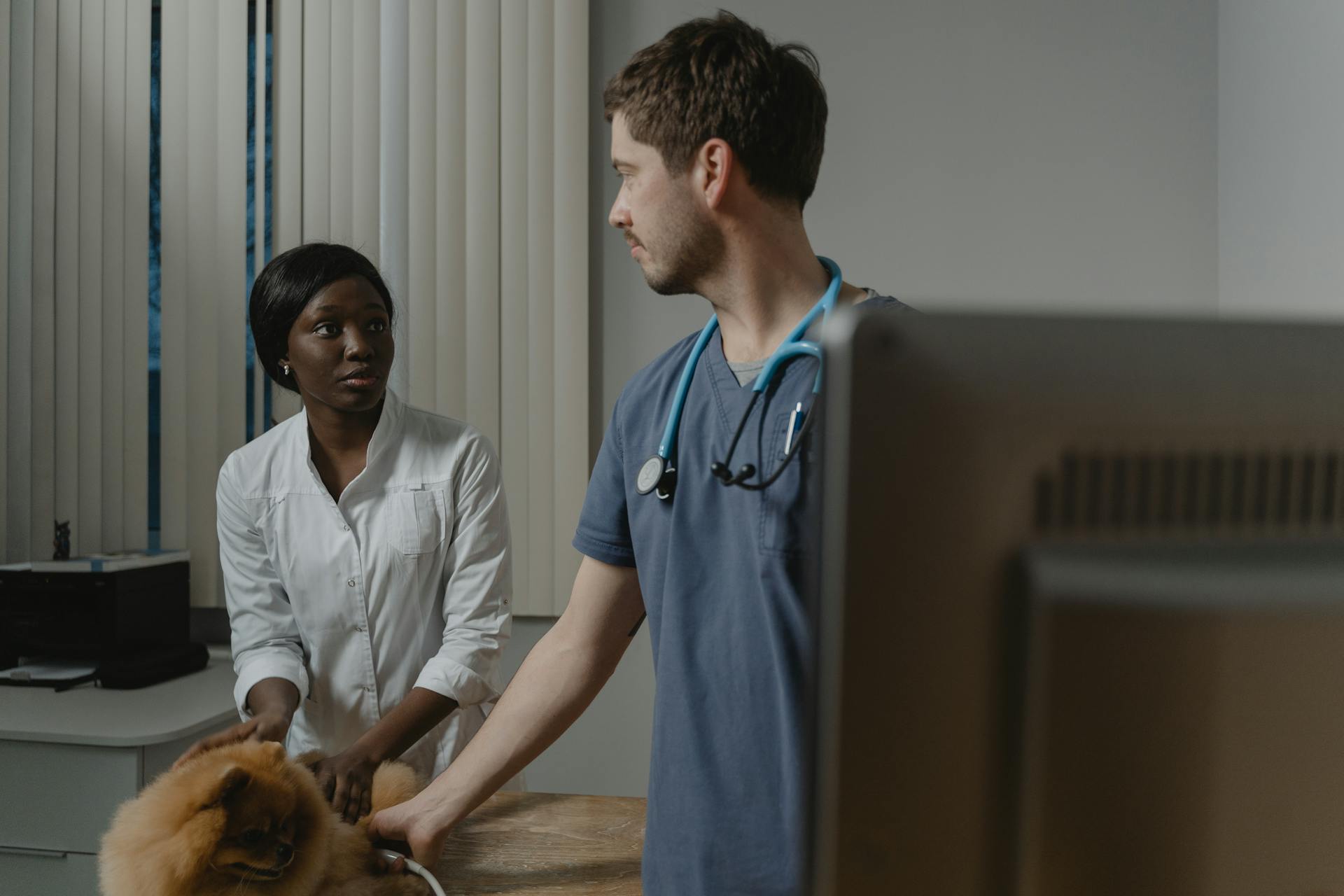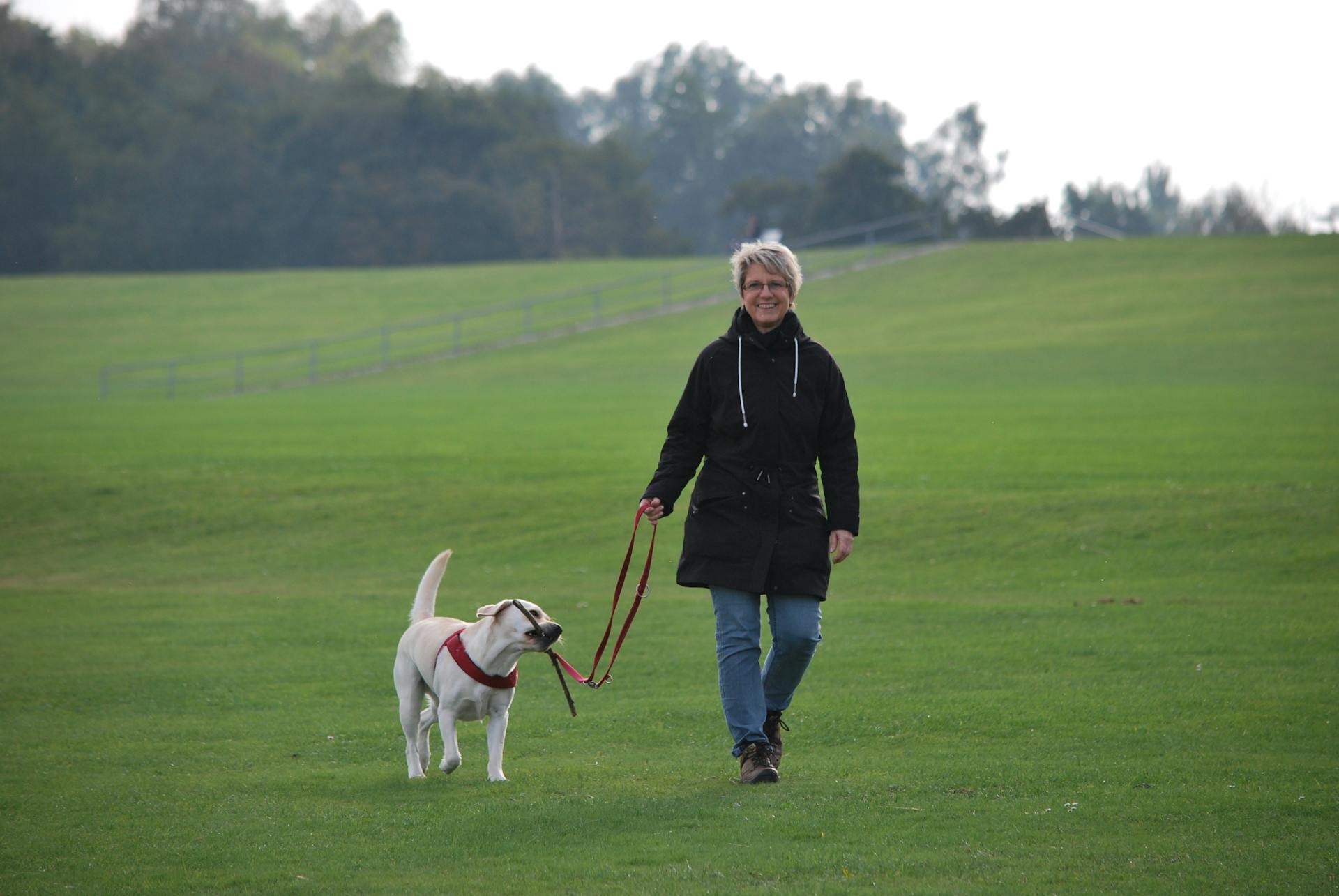
Labradors are prone to developing bumps on their skin, and it's essential to understand the common causes and symptoms to ensure your furry friend receives the right treatment.
One common cause of bumps on Labrador Retrievers is skin allergies, which can lead to itchy, inflamed skin and the formation of bumps.
Labradors can develop skin allergies due to environmental factors, such as pollen or dust, or food allergies, which can cause digestive issues and skin problems.
A skin allergy can cause bumps on a Labrador's skin to become red, inflamed, and itchy, leading to excessive scratching and chewing.
Labradors with skin allergies may also develop secondary infections, which can cause pus-filled bumps on the skin.
Intriguing read: Schnauzer Bumps Home Remedy
Types of Bumps
Labradors can develop various types of bumps, and it's essential to know what to look for. Some common types of bumps on Labradors include fatty tumors, also known as lipomas, which can appear anywhere on the body, especially around the ribs, and are more common in middle-aged or older dogs.
For another approach, see: What Types of Labrador Retrievers Are There
These fatty tumors are considered a natural part of aging, and any breed can have them, but larger dogs and those who are overweight are more prone to them. You may also notice sebaceous cysts, which are blocked oil glands that look like pimples and can burst, releasing a white, pasty substance.
Labradors can also develop warts, caused by a virus, which can appear around the mouth and typically have a cauliflower appearance. If your Labrador has a bump, it's crucial to keep an eye out for others and have new ones tested, even if they're not cancerous.
Here are some common types of bumps that can appear on Labradors:
- Fatty tumors (lipomas)
- Sebaceous cysts
- Warts (papillomas)
- Abscesses (buildups of pus under the skin)
- Mast cell tumors (skin cancer)
Lipoma
Lipoma is a common type of benign skin tumor found in dogs, identified by the collection of fat cells on the outside or inside the dog's body.
It usually grows on the pet's abdomen, chest, or legs, and some dogs don't have a lipoma in their entire life, while others can have multiple lipomas throughout their life. Lipomas can grow between the dog's muscle layers, causing the condition known as an infiltrative lipoma.
A fast-growing lipoma can affect a dog's blood supply and cause pain, and lipomas can also affect the daily activities of dogs, including their mobility.
Any breed can develop lipomas, although larger dogs and those who are overweight are more prone to them. Lipomas are considered a natural part of aging and are most common in middle-aged or older dogs.
Here are some common characteristics of lipomas:
- They can feel "squishy" or "firm" in texture.
- Some lipomas are round or oval, while others can be irregular or more bulging.
- They can be firmly stuck in their places but can be moved around a little if they are not attached to the surrounding tissues.
Skin Tag
Skin tags are common in older dogs, just like they are in older people. They're harmless, fibrous growths that can extend from the skin's surface by a stalk.
Dogs can have one skin tag or many, and they often appear on areas like the chest, legs, face, back, armpits, or other parts of the body. Large-breed dogs may be at greater risk of developing skin tags.
You might enjoy: Older Maltese Dogs
Warts (Papillomas)
Warts, also known as papillomas, are small growths that can pop up on a dog's skin suddenly.

They're usually benign, but can be contagious between dogs, often occurring on the face, eyelids, mouth, genital area, lower legs, feet, footpads, and between the toes.
Dogs can get warts just like people do, and they tend to have a cauliflower appearance, growing alone or in clusters.
Dog warts are typically found on areas of the body that are more prone to skin-to-skin contact with other dogs, making them a common issue for dogs that interact closely with each other.
Causes and Symptoms
Causes of bumps on Labrador Retrievers can be quite varied, including fat, tumors, cysts, and even hernias, which occur when a tissue or organ protrudes through another into an abnormal place on the body.
Some bumps on Labradors can be caused by infections, such as abscesses, or allergic reactions, which can be treated with medication. However, many lumps can feel and look identical, making it difficult for a veterinarian to determine their type just by feeling them.
Lipomas in dogs, which are common in Labradors, are often caused by a combination of environmental and genetic factors, but there is no specific cause that has been identified.
Causes

Lumps and bumps on your pet can be caused by a variety of things, including fat, tumors, cysts, infection, allergic reactions, and swelling from injury or hernia.
Fat is one common cause of lumps and bumps, especially in areas where your pet tends to store fat, such as their abdomen or neck.
Tumors can also cause lumps and bumps, and they can be either benign or malignant. However, it's worth noting that your veterinarian may not be able to determine the type of tumor just by feeling it.
Cysts and infections, such as abscesses, can also cause lumps and bumps. These types of lumps are often painful and may require veterinary attention.
Allergic reactions can also cause lumps and bumps, often in the form of hives or itchy skin.
Swelling from injury or hernia can also cause lumps and bumps, and may require veterinary attention to determine the underlying cause.
It's worth noting that many lumps and bumps can feel and look identical, which can make it difficult for veterinarians to determine their cause without further testing.
Curious to learn more? Check out: Fat Bichon Frise
Causes of Lipoma in Dogs
Lipoma in dogs is a common condition that's still not fully understood. There is no specific cause for lipoma in dogs.
Most health care professionals believe that lipoma, as well as some cancers, are caused by different environmental and genetic factors combined.
While we don't know the exact cause, it's clear that lipoma is influenced by a combination of factors.
All types of dog breeds are vulnerable to developing lipoma, but some breeds are more at risk than others.
Doberman pinschers, Labrador retrievers, Cocker spaniels, and Golden retrievers are more likely to develop lipoma.
Discover more: Retrieving Breeds
Diagnosis and Treatment
Your veterinarian will evaluate the lump or bump to determine if it's a benign growth or something more serious. They may use cytology, a test where they poke the lump with a small needle to collect a sample for examination.
There are three main options for diagnosis: cytology, mapping, and full surgical excision. Cytology is a quick and non-invasive test that can usually be completed in the veterinary clinic without sedation.
Recommended read: Canine Brucellosis Test
If the lump is rapidly growing, a next step may be recommended, such as a biopsy or surgical excision.
The best treatment for lipomas in dogs is surgical removal, but some vets also opt for monitoring their growth. Your veterinarian will determine the best course of action based on the size and type of lump.
If you decide to monitor the growth, keep track of the size and any changes in shape or firmness. Take photos or note the size every six months to compare the growth.
Here are the three main options for diagnosis:
- Cytology: a quick and non-invasive test that can usually be completed in the veterinary clinic without sedation
- Mapping: measuring the size and monitoring growth to determine if a next step is needed
- Full surgical excision: removing the entire growth and submitting it to a pathologist for evaluation
Pet Lump Diagnosis
Your veterinarian has several options to determine if a lump on your pet is something to worry about. Cytology is a test that can be completed in the clinic, usually without sedation, by aspirating the lump with a small needle and examining the sample under a microscope.
To prepare for a vet visit, it's helpful to mark the lump with a marker or draw a circle around it, especially if it's hard to find or your pet is very hairy. This can make it easier for your vet to evaluate the lump.
Consider reading: Bernese Mountain Dog at Vet
Your vet will measure the size and monitor growth of the lump. If it's rapidly growing, a next step may be recommended. Local biopsy, which requires sedation and pain medication, can be completed in the clinic, and a full surgical excision may be necessary to remove the entire growth.
Lipoma is a common type of benign skin tumor found in dogs, identified by the collection of fat cells on the outside or inside the dog's body. Lipomas usually grow on the pet's abdomen, chest, or legs.
A lipoma can grow without limits, and a fast-growing lipoma can affect a dog's blood supply and cause pain. Lipomas can also affect a dog's daily activities, including their mobility.
All types of dog breeds are vulnerable to developing lipoma, but Doberman pinschers, Labrador retrievers, Cocker spaniels, and Golden retrievers are more at risk.
Here are the different diagnostic options for pet lumps:
- Cytology: a test that can be completed in the clinic, usually without sedation
- Mapping: measuring the size and monitoring growth of the lump
- Local biopsy: requires sedation and pain medication
- Full surgical excision: removing the entire growth
Treatment for Dog Lipomas
The best treatment for lipoma in dogs is surgical removal, but some vets also opt for monitoring their growth.
If the lipoma is small, the surgery is usually less invasive, and the incision is less painful to your pet.
Lipomas don't usually cause problems, but they can begin to affect mobility, so it's essential to keep an eye on them.
You can also keep a record of photos to compare the growth easily, and note the size of the lump at least every six months.
If your dog seems unaffected by the lump, don't worry, but if you observe them being irritated or struggling to walk properly, you should talk to your vet about surgery.
Surgery may not be the only option, as some vets recommend a monitoring approach to track the size and growth of the lumps.
Developing a diet plan for your dog can help control the growth of lipomas and avoid their development in the future, as some lipomas shrink with weight loss.
Recurring infiltrative lipomas and liposarcomas can occur after surgery, so the vet may recommend surgical removal again, followed by radiation therapy.
A unique perspective: Why Are Labradors so Friendly
Cancerous Lumps in Dogs
As your Labrador retriever ages, it's not uncommon for them to develop lumps in or under the skin. Regular check-ups and grooming services will help catch anything you don't notice at home.
If your dog has lost a lot of weight and they're not on a diet, it's time to get them checked out. Even if they don't have cancer, it could be an indication of another health problem.
Some common types of cancerous lumps in dogs include Mast Cell Tumour, which is cancer of the immune system and blood cells, and Fibrosarcoma, which are invasive cancers that look like lipoma.
Mast Cell Tumour and Fibrosarcoma are just two of the more common types of cancerous lumps that a dog might develop. Other types include Melanoma, Squamous Cell Carcinoma, Mammary Carcinoma, and Osteosarcoma.
Here are some of the most common types of cancerous lumps in dogs:
Sudden Appearance
If you notice a lump on your Labrador retriever that develops suddenly, it's essential to visit the vet right away.
A lump that grows over time is often not a cause for concern, but a sudden appearance is a warning sign that requires attention.
Some lumps and bumps grow over time, but a lump that develops suddenly is a warning sign to visit the vet.
Sources
- https://www.webmd.com/pets/dogs/dog-lumps-bumps-skin
- https://www.diamondpet.com/blog/health/sensitive-skin/the-12-lumps-and-bumps-of-canine-skin/
- https://knutsfordvetsurgery.co.uk/cancerous-lumps-on-dogs/
- https://www.texvetpets.org/article/lumps-bumps-when-is-it-serious/
- https://www.webmd.com/pets/dogs/what-to-know-lipoma-in-dogs
Featured Images: pexels.com


